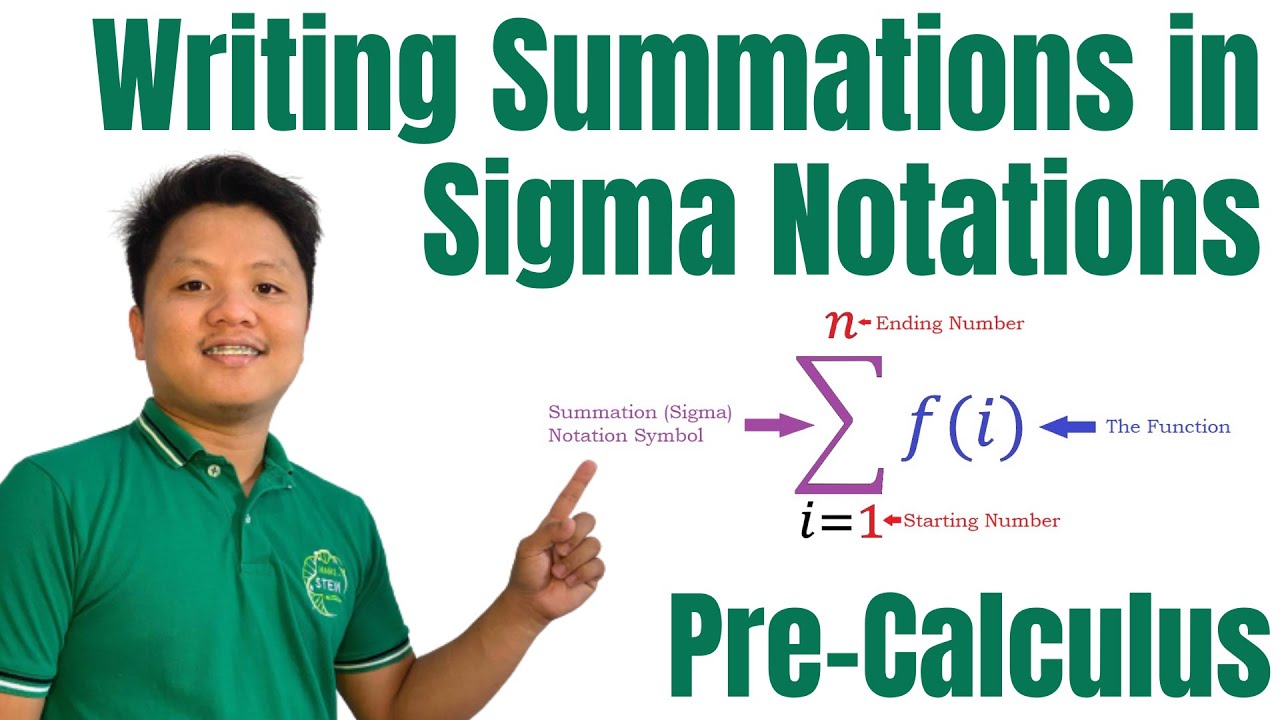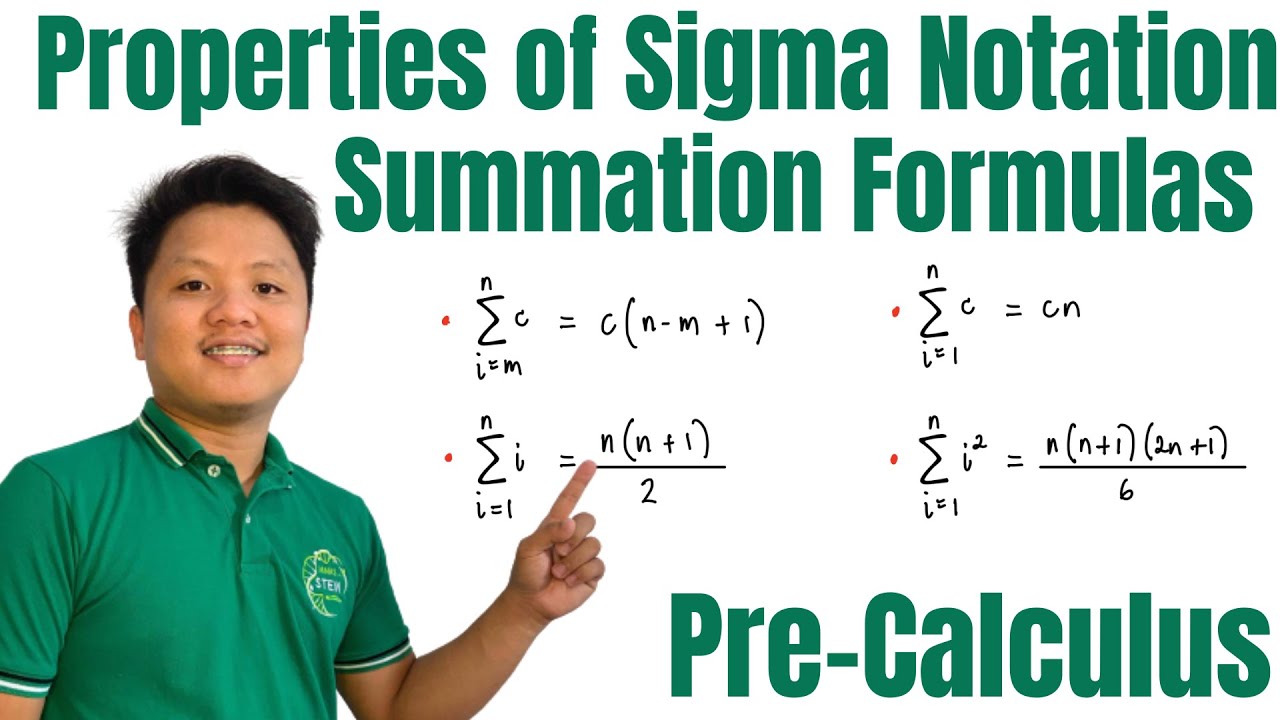Summation Notation Practice | MIT 18.01SC Single Variable Calculus, Fall 2010
TLDRIn this video, the professor explains sigma notation through practice problems. The first task involves filling in blanks to make sums equal, focusing on understanding each part of the notation. The second task is to simplify three finite sums into one or two sums without calculating the total. The professor demonstrates the solutions, emphasizing the significance of understanding how sigma notation components work and how to manipulate them effectively. A final task is presented, where viewers are encouraged to write a sum in sigma notation. This exercise is intended to enhance familiarity and comfort with sigma notation.
Takeaways
- 📚 The video is focused on practicing sigma notation, a mathematical notation used to represent the sum of a sequence of terms.
- 🔍 The first problem involves filling in blanks to make two sums equal without writing out all terms, emphasizing understanding the components of sigma notation.
- 📉 The second problem is about simplifying three finite sums into one or two sums, maintaining the notation form for easier manipulation.
- 🌟 Sigma notation simplifies the process of summing sequences by identifying patterns and reducing the need to write out all terms.
- 🔑 The importance of understanding the index, limits, and the power to which the base is raised in sigma notation is highlighted.
- 🧩 The video demonstrates how to manipulate exponents and indices to match the given sums, ensuring the sums are equal by adjusting the power and starting index.
- 📈 The concept of splitting sums and combining like terms is introduced to simplify expressions, which is crucial for complex summations.
- ✂️ By identifying common terms and subtracting overlapping parts, the sums can be reduced to a simpler form, as shown in the video.
- 📝 The video provides a step-by-step approach to simplifying sums, emphasizing the need to keep track of indices and terms carefully.
- 🔄 The process of alternating signs in a sequence can be represented by raising -1 to a power, which depends on the desired starting term's sign.
- 📐 The final part of the video challenges viewers to convert a given sequence into sigma notation, showcasing flexibility in approach and solution.
- 📘 The video concludes by emphasizing the utility of sigma notation in simplifying and manipulating sums, encouraging further practice for mastery.
Q & A
What is the main focus of the video script?
-The main focus of the video script is to practice and understand sigma notation, specifically how to fill in blanks to make sums equal and how to simplify finite sums.
What is the first type of problem discussed in the script?
-The first type of problem discussed is a fill-in-the-blanks problem where students are asked to complete sums in sigma notation without writing out all the terms.
What is the second type of problem the professor asks students to work on?
-The second type of problem is a simplification problem where students are asked to combine three finite sums into one or two simplified sums, keeping it in notation form.
How does the professor suggest simplifying the expression 2^(k-2)?
-The professor suggests simplifying the expression by adjusting the index 'k' to start at 3, making the power 'k-2' so that when 'k' is 7, the power becomes 5, matching the given sum.
What is the significance of ensuring the same number of terms in the sums when trying to equate them?
-Ensuring the same number of terms is crucial because it guarantees that the sums are comparable and can potentially be equal, which is the goal of the exercise.
How does the professor handle the third sum where a factor of 2 is pulled out?
-The professor rewrites the expression by pulling the 2 back in, resulting in 2^(k+1), and then adjusts the index 'k' to start at 0 and end at 4 to match the desired range of the exponents.
What is the strategy for simplifying the sums of n^3 - n^2, n^3 - n, and n from 1 to 100 and 45 to 100?
-The strategy involves splitting the terms and combining them where possible, ensuring the correct indices are used, and then subtracting overlapping terms to simplify the expression.
What is the final simplified form of the sums given in the script?
-The final simplified form is the sum from n=1 to 44 of n^3 - n^2 - n, which results from combining and subtracting the overlapping terms from the original sums.
What is the task given to the students at the end of the script?
-The task is to write a given sum of five terms in sigma notation, with the possibility of multiple correct solutions depending on the approach taken.
How does the professor recommend starting the sigma notation for the final task?
-The professor recommends starting by pulling out a common factor, in this case, 1/5, and then determining the index and range based on the pattern of the terms.
What is the importance of sigma notation in mathematics?
-Sigma notation is important as it provides a concise way to represent and manipulate sums, making it easier to understand and work with series and sequences in mathematical expressions.
Outlines
📚 Introduction to Sigma Notation Practice
The professor begins the recitation by introducing the topic of sigma notation and its importance in mathematical practice. The goal is to ensure students are comfortable with the notation and its components. Two types of problems are presented: a fill-in-the-blanks problem involving equal sums and a simplification problem for finite sums. The professor emphasizes the importance of understanding the notation without having to write out all terms, aiming to simplify expressions while keeping them in a notation form.
🔍 Analyzing and Simplifying Sigma Notation Problems
This paragraph delves into the process of solving the first problem, which involves understanding the index and power in sigma notation. The professor guides through filling in the blanks to equalize sums, using the given information effectively. The second problem focuses on simplifying three finite sums by combining them into a single or two sums, emphasizing the need to keep the sums in notation form. The professor demonstrates how to split and combine terms while maintaining the correct index, resulting in a simplified expression of the sums from 1 to 44 of n cubed minus n squared minus n.
📝 Writing a Series in Sigma Notation
The final paragraph introduces a new problem where the task is to express a given series of five terms in sigma notation. The professor suggests starting by identifying and factoring out common elements to simplify the expression before applying sigma notation. An example is provided where the common factor 1/5 is pulled out, and the series is rewritten with alternating signs and increasing denominators. The professor outlines the steps to determine the correct index, starting value, and ending condition for the sigma notation, emphasizing the flexibility in choosing the starting point and power for the alternating signs.
Mindmap
Keywords
💡Sigma Notation
💡Summation
💡Index
💡Exponent
💡Fill-in-the-blanks
💡Simplification
💡Combining Sums
💡Factor
💡Alternating Sign
💡Denominator
💡Cubing
Highlights
Introduction to practicing sigma notation with a few short problems to understand its components.
First problem involves fill-in-the-blanks to make two sums equal without writing out all terms.
Second problem focuses on simplifying three finite sums into a single or two sums using notation.
Understanding the index and power in sigma notation to match the given sums.
Adjusting the power of k to make the sums equal by using k-2.
Ensuring the same number of terms are summed over by matching the ranges of k.
Third problem involves factoring out a 2 and adjusting the exponent and index accordingly.
Simplifying the sums by combining like terms and adjusting indices to match.
Splitting the second term to help simplify the first and third terms.
Combining the sums into a single summation by matching indices and simplifying.
Subtracting overlapping terms to simplify the sums further.
Final simplification results in n from 1 to 44 of n cubed minus n squared.
Writing a sum of five terms in sigma notation by factoring out common terms first.
Using negative one raised to a power to alternate the sign in sigma notation.
Determining the correct index and stopping point for the sigma notation.
Highlighting the flexibility in choosing different powers and starting points for sigma notation.
Emphasizing the importance of understanding sigma notation for easy manipulation.
Transcripts
Browse More Related Video

Writing Summations in Sigma Notation | Series and Sigma Notation | Pre-Calculus

Properties of Sigma Notation and Summation Formulas | Pre-Calculus

Sigma notation for sums | Sequences, series and induction | Precalculus | Khan Academy

Summation Formulas and Sigma Notation - Calculus

Worked example: Riemann sums in summation notation | AP Calculus AB | Khan Academy

The Definite Integral Part II: Using Summation Notation to Define the Definite Integral
5.0 / 5 (0 votes)
Thanks for rating: